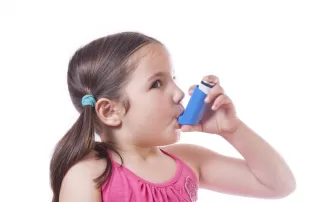Asthma
Welcome to Qoctor’s online doctor service which can provide assessment for Asthma. Answer some online questions, then book a video consultation with an AHPRA-registered doctor. Repeats available (subject to assessment).
The consultation fee is $29.99. If a prescription is advised, it can be sent as an eScript to your phone OR electronically to your local pharmacy. Alternatively you can have medication delivered by an Australian partner pharmacy- in this case, the cost of medication is added at the checkout. All treatment and advice is issued subject to your doctor’s assessment.
About Asthma
- Asthma affects around 1 in 20 adults and is caused by inflammation and over-sensitivity of the lungs, which can lead to sudden narrowing of the airways. Common symptoms include cough, wheeze, shortness of breath and chest tightness. It can be triggered by many things, including viruses, dust and pollen.
- Asthma can start at any age, though it most commonly develops during childhood. It is generally diagnosed based on the symptoms, which tend to get better when inhalers are used. However, sometimes investigations may be needed to confirm the diagnosis.
- For most people who have asthma, treatment involves taking a reliever inhaler when symptoms flare up. Many people also need to take a daily preventer inhaler, to reduce inflammation in the lungs and stop symptoms happening in the first place. And sometimes an oral medication may be used as a preventer.

Common Questions and Answers
If you have asthma or hay fever you may be at risk of thunderstorm asthma- particularly in spring and summer. Thunderstorm asthma can be very dangerous, leading to severe difficulty breathing. It can be life-threatening, even in people who do not usually get asthma. If you have asthma or hay fever, you should speak to your doctor about how to protect yourself, in advance of thunderstorm season.
What causes Thunderstorm Asthma?
It is thought that thunderstorm asthma events are triggered by a combination of high grass pollen levels in the air and a certain type of thunderstorm. Pollen grains get swept up and carried long distances. Pollen grains can burst apart in these conditions, releasing tiny particles that can get deep into a person’s airways, triggering asthma symptoms.
Some steps to take to protect yourself against Thunderstorm Asthma:
- Make sure your asthma is properly controlled (see below). If it is not, speak to your doctor. You can also take an Asthma Control Test , available on the Asthma Australia website – and see your doctor urgently if your score is under 20.
- Discuss treatment of asthma and hay fever regularly with your doctor, particularly if you have symptoms or if there is high risk weather coming. Have an asthma action plan.
- Use your asthma preventer inhaler every day during high risk weather, even when well.
- Carry an asthma reliever puffer with you at all times
- If you have hay fever, use a steroid nasal spray every day when the pollen count is high.
- Follow your local weather forecast for warnings about high thunderstorm asthma risk levels (For VIC, NSW, ACT and QLD go HERE to monitor the pollen forecast, and for TAS go HERE).
- Stay indoors with windows shut on days the pollen count or thunderstorm asthma risk is known to be high.
See a doctor immediately or call Triple Zero (000) if you experience difficulty breathing.
Signs of Good Asthma Control
Asthma is well controlled if :
- most days, you don’t have any breathing difficulties, cough or wheeze.
- you generally sleep through the night, without waking due to asthma symptoms like cough, wheeze, or chest tightness
- you can exercise without getting asthma symptoms (some people need to use their reliever beforehand, to achieve this)
- you don’t miss work or school due to asthma
- you do not need to use your reliever inhaler more than 2 times per week (except for exercise)
Asthma control can also be checked by having a breathing test (spirometry).
There are many reliable sources of information about asthma in Australia. If you need one to one assistance, you can also make an appointment to see your GP, practice nurse, or speak to your local pharmacist.
- The Royal Children’s Hospital website has some great content relating to asthma in kids. Start HERE.
- The National Asthma Council has videos teaching you how to use your specific inhaler correctly, as each brand and model has its own special technique ( a majority of people get it wrong, even people who have used a puffer for many years!). Start HERE.
- The Australian government also provides reliable, accurate up to date advice about many health conditions, including asthma on the Health Direct website. Start HERE.
- Asthma Australia, is a consumer organisation that provides support and education about asthma. They can offer free telephone sessions with an asthma educator- this can be really useful if you need advice about your asthma management. Start HERE.
There can be many reasons for poor asthma control- here are some common ones:
Some possible reasons for bad asthma control
- Not using the right medication to treat your asthma. Understanding the different types of inhalers (puffers) and when to use them is key to good asthma control- speak to your doctor or pharmacist if your are not 100% sure about when to take which inhaler.
- Incorrect inhaler technique (using your puffer the wrong way) is very common- in fact most people with asthma do not use their inhaler(s) correctly! This means you don’t get the full dose of medication into your lungs each time, which can lead to poor asthma control. A GP, pharmacist or practice nurse can usually help to improve your technique. There are also good educational resources available to help. The Australian National Asthma Council has “how to” videos for every type of inhaler. Check it out here.
- Forgetting to take your “preventer” inhaler regularly.
- Exposure to triggers such as dust, pollen, smoke, fumes etc. You can work with your doctor to try to work out your triggers and how to avoid them, where possible.
- Relying too much on your “reliever” inhaler. If you are using your reliever puffer more than twice a week, you should speak with your doctor about your asthma control.
- Not having (or following) an Asthma Action Plan when your asthma symptoms are worsening.
If you think you have poor asthma control your should speak to your doctor- they can look for the causes and help you improve your asthma management.
To get your regular asthma prescription online with Qoctor, start HERE.
To get an asthma action plan online, from an AHPRA registered Australian doctor, start HERE.
Asthma is a lifelong (chronic) condition. It is important to make sure your asthma is well controlled, to reduce the risk of dangerous asthma attacks, and long term damage to your lungs. Whilst there is no permanent cure for asthma, you can reduce or eliminate symptoms by knowing your triggers, and understanding how to treat worsening asthma. Studies show that while many people think that their asthma is well controlled, a majority don’t actually have good control!
Signs of Good Asthma Control
Asthma is well controlled if :
- most days, you don’t have any breathing difficulties, cough or wheeze.
- you generally sleep through the night, without waking due to asthma symptoms like cough, wheeze, or chest tightness
- you can exercise without getting asthma symptoms (some people need to use their reliever beforehand, to achieve this)
- you don’t miss work or school due to asthma
- you do not need to use your reliever inhaler more than 2 times per week (except for exercise)
Good asthma control can be measured by having a breathing test (spirometry)
Signs of Poor Asthma Control
Asthma is poorly controlled if you:
- have frequent breathing difficulties, coughing or wheezing most days
- experience disturbed sleep due to asthma
- can’t exercise or exert yourself physically without experiencing breathing difficulties, cough and/or wheeze
- often miss work or school due to asthma
- use your reliever medication more than 2 times per week.
If you do not have an asthma “action plan” or if you are unsure whether you have good asthma control, you should speak to your doctor.
Yes. Qoctor can provide assessment for your usual asthma treatment online, if you have previously been diagnosed with asthma and are already using an inhaler (puffer).
First, you’ll need to have a telehealth consultation with one of our doctors. The doctor will ask some questions to confirm the diagnosis and to ensure that:
- your asthma is stable and well-controlled.
- there are no other significant health issues present.
- you are not getting any side effects from your current treatment.
If a prescription is issued, we can send a prescription immediately to your pharmacy. Or you can request for a paper prescription or the medication itself to be posted to you.
To book an appointment with an AHPRA registered, Australian doctor, to request your asthma inhaler start <HERE>. Same day appointments are usually available. A telehealth consultation for asthma treatment costs $26.99 (plus delivery).
Please note, all treatment and advice is issued subject to your consultation and doctor’s assessment.
Qoctor can provide assessment for your asthma, and may be able to issue your usual asthma treatment online, if you have previously been diagnosed with asthma and are already using an inhaler (puffer).
First, you’ll need to have a telehealth consultation with one of our doctors. The doctor will ask some questions to confirm the diagnosis, and to ensure that:
- your asthma is stable and well-controlled.
- there are no other significant health issues present.
- you are not getting any side effects from your current treatment.
If a prescription is issued, we can send a prescription immediately to your pharmacy. Or you can request for a paper prescription or the medication itself to be posted to you.
To book an appointment with an AHPRA registered, Australian doctor, to request your asthma inhaler start <HERE>. Same day appointments are usually available. A telehealth consultation for asthma treatment costs $26.99 (plus delivery, if applicable).
Please note, all treatment and advice is issued subject to your consultation and doctor’s assessment.
What is Asthma?
Asthma is a common, long term medical condition that affects the airways (the breathing tubes that carry air into the lungs), causing them to become narrowed and inflamed. Around 1 in 20 people are affected by Asthma, including adults and children.
People with Asthma sometimes find it harder to breathe in and out, because their airways become narrower or constricted. They also may produce more mucus. This can lead to symptoms such as coughing, wheezing ( a whistling sound when breathing out), shortness of breath and a sense of chest tightness. These symptoms may be worse at night, leading to difficulty sleeping.
Asthma may be triggered by different things in different people, such as viral infections, exercise, dust, pollen, cold air, animal dander, fumes or chemicals.
It is not clear why some people develop Asthma and others don’t, but some factors that increase the risk of getting Asthma include:
- family history of Asthma
- being born premature or low birth weight
- if your mother smoked during pregnancy
- exposure to air pollution or smoke in childhood
There is no cure for Asthma, but it can usually be well controlled with the right treatment and action plan. Most people with Asthma can stay active and lead a normal, healthy life.
For good control of Asthma, you need:
- inhalers – taken in the right way, at the right time
- regular check-ups with your doctor, particularly if you have worsening symptoms
- information about managing asthma correctly
- an asthma action plan, so you know exactly what to do when symptoms flare up.
Severe Asthma
Severe Asthma attacks can be dangerous- even life-threatening, and if you have symptoms of severe Asthma you should seek immediate medical attention, as well as taking your reliever inhaler. Having an Asthma action plan means you’ll know what to do if severe Asthma occurs.
Signs of an Asthma emergency include:
- Rapid worsening of shortness of breath and wheezing
- No improvement in symptoms, even after using your “reliever” inhaler (for most people this is a “blue puffer”, also known as Ventolin or Salbutamol.
- Shortness of breath on minimal physical exertion
The doctors at Qoctor can provide assessment for Asthma, in people whose Asthma is stable and controlled, and who wish to request ongoing treatment. Following a video consultation, if a prescription is issued, it can be sent to your local pharmacy, or you can have the medication delivered. Start HERE to request an assessment.
Further asthma resources:
The main 4 symptoms of Asthma are:
- cough
- wheeze (a high-pitched, whistling sound when breathing out- this is a common feature of Asthma in children)
- chest tightness
- difficulty breathing/ shortness of breath
Asthma is often worse at night, which can lead to poor sleep and tiredness.
Asthma symptoms are commonly brought on by specific triggers, though these can vary from person to person.
Common triggers of Asthma symptoms include:
- respiratory viruses (such as the common cold, influenza, COVID-19 etc )
- cold air
- exercise
- pollen
- dust
- mould
- animal dander
- smoke
- chemicals or fumes
What are the symptoms of severe Asthma?
- Shortness of breath
- Unable to speak in full sentences
- Chest tightness
- Feel breathless even when resting
- A blue colour around the mouth/lips
- Feeling restless, confused or difficulty concentrating
- A feeling of strained muscles in your tummy and neck
- Feeling that you need to stay upright to breathe more easily
Cough and wheeze are not always present in severe Asthma.
Call triple zero (000) for an ambulance if symptoms of severe asthma are present, and you are not responding to your usual inhalers.
Asthma is the most common chronic disease in children.
- Asthma can start at any age but it most commonly starts in childhood.
- Approximately 1 in 10 Australians have Asthma.
- People with a family history of Asthma or allergies may be at higher risk of developing Asthma.
- Asthma is also more common in people who were born premature, had low birth weight or whose mother smoked during pregnancy.
- Exposure to smoke or air pollution in childhood also increases the risk of Asthma.
- Indigenous Australians were 1.6 times more likely than the rest of the population to report having Asthma, in recent studies.
Asthma more commonly affects boys in childhood, but tends to affect more females later in adulthood.
Asthma symptoms may flare up at any time.
Common triggers for Asthma include:
- Infections
- Hay fever/pollen
- Exercise
- Smoking
- Allergies to animals
- House dust mite exposure
- Fumes or chemicals
- Medications including:
- Aspirin
- Anti-inflammatories (e.g Ibuprofen, Diclofenac)
- Beta-blockers (e.g Propranolol, Atenolol)
- Your doctor can usually diagnose Asthma based on the history of your symptoms and by performing a physical examination.
- Usually no tests are required but further tests can be arranged if required.
- These include peak flow assessment or spirometry (lung function testing).
- Asthma is usually treated with inhalers which deliver medication directly into the lungs.
- Inhalers are often more effective if used with a spacer device, though some have an in-built delivery system and a spacer is not needed- it’s worth checking with a pharmacist if you’re unsure..
- An oral medications may also be used as a preventer.
- The treatment is categorised into Preventers (stopping you from getting asthma symptoms) and Relievers (treating Asthma symptoms when present):
Relievers:
- These are taken to relieve symptoms when they occur. They help to open up the airways and are also called bronchodilators
- If you have mild Asthma then this may be the only treatment you require.
- If you are need to take your reliever inhaler more than three times a week, then you may require treatment with a preventer inhaler.
Preventers:
- These are taken regularly to prevent symptoms of Asthma.
Steroid inhalers
- The most commonly used preventer is a steroid which works by reducing the inflammation in the airways.
- It may take up to 2 weeks for the steroid to build up their effect.
- They should be taken regularly to control your asthma.
- You should always rinse your mouth after taking your steroid inhaler.
- Long term use of steroid inhalers can cause low bone density.
Long acting bronchodilators
- These relieve symptoms for up to 12 hours after each dose has been taken.
- A long-acting bronchodilator may be needed if symptoms are not fully controlled by the steroid inhaler alone.
Combination medications
- Some inhalers may contain both steroid and long acting bronchodilators.
Leukotriene receptor antagonists
- These block the effect of chemicals called leukotrienes which trigger asthma symptoms.
- This medication needs to be taken regularly to prevent Asthma.
If your Asthma remains poorly controlled then your doctor may refer you to a specialist for further assessment and management.
Health Library- Asthma & Allergies
Food allergies in Australian children- what you need to know
Food allergies in Australian children- what you need to know Food allergies are on the rise in Australia, affecting 5-10% of children. Understanding allergies, recognising the symptoms, and knowing how to respond can help parents to feel less stressed about their child's condition, and manage the risks more effectively. Book a GP appointment Common allergens There are over 170 known food triggers for allergies. The most frequent triggers of food allergies in children include: Eggs Cow's milk Peanuts Tree nuts (such as almonds and cashews) Sesame Soy Wheat Fish and shellfish These allergens account for the majority of allergic reactions in children, with peanuts, tree nuts, and seafood often resulting in lifelong allergies. Many children outgrow allergies to dairy products and eggs. Symptoms to watch for Food allergy symptoms can vary widely [...]
Mould- a cause of asthma and allergies
Is your home causing Asthma? Overview Our homes are not just a roof over our heads- they play a key role in our health, particularly when it comes to allergies and asthma. A study carried out by Asthma Australia in 2022 showed that almost one third of people with asthma or allergies find their symptoms get worse when they are at home, regardless of whether they are owners or renters! We all want a safe and healthy place to live- so, as an asthma or allergy sufferer, what are some of the key things to check in your house? Request a prescription Cooktops & rangehoods Gas cooktops are often preferred by home cooks, but they are linked with poor health, as the burning of gas releases many nasty substances that cause [...]
Why request an Asthma Action Plan?
Why request an Asthma Action Plan? What is an asthma action plan? A key part of asthma management is the preparation of a written asthma action plan by the person with asthma and/or their carer, together with their doctor. An asthma action plan is a document that helps the person with asthma and those who care for them, to recognise worsening asthma symptoms and to take the correct steps to safely manage them. REQUEST AN ASTHMA ACTION PLAN What information is contained in an asthma action plan? Factors that make your asthma worse (triggers). Medicines you take to treat your asthma, with the names of each medicine/inhaler Symptoms and/or peak flow measurements that indicate worsening asthma Which medicines/inhalers to take based on symptoms or peak flow measurements Symptoms that indicate a need for [...]



